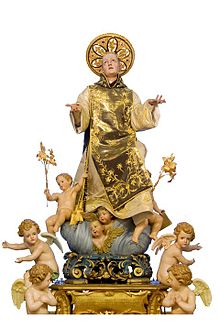
The Benedictines, officially the Order of Saint Benedict, are a mainly contemplative monastic religious order of the Catholic Church for men and for women who follow the Rule of Saint Benedict. The male religious are also sometimes called the Black Monks, in reference to the colour of their religious habits, in contrast to other Benedictine orders such as the Olivetans, who wear white. They were founded in 529 by Benedict of Nursia, a 6th-century Italian monk who laid the foundations of Benedictine monasticism through the formulation of his Rule. Benedict's sister, Scholastica, possibly his twin, also became a religious from an early age, but chose to live as a hermit. They retained a close relationship until her death.
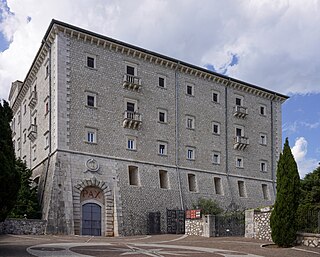
Monte Cassino is a rocky hill about 130 kilometres (80 mi) southeast of Rome, in the Latin Valley, Italy, 2 kilometres west of Cassino and at an elevation of 520 m (1,710 ft). Site of the Roman town of Casinum, it is widely known for its abbey, the first house of the Benedictine Order, having been established by Benedict of Nursia himself around 529. It was for the community of Monte Cassino that the Rule of Saint Benedict was composed.
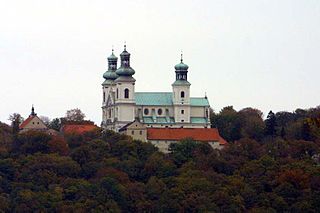
The Camaldolese Hermits of Mount Corona, commonly called Camaldolese, is a monastic order of Pontifical Right for men founded by Saint Romuald. Its name is derived from the Holy Hermitage of Camaldoli, high in the mountains of central Italy, near the city of Arezzo. Its members add the nominal letters E.C.M.C. after their names to indicate their membership in the congregation. Apart from the Roman Catholic monasteries, in recent times ecumenical Christian hermitages with a Camaldolese spirituality have arisen as well.

The Olivetans, formally known as the Order of Our Lady of Mount Olivet, are a monastic order. They were founded in 1313 and recognised in 1344. They use the Rule of Saint Benedict and are a member of the Benedictine Confederation, where they are also known as the Olivetan Congregation, but are distinguished from the Benedictines in their white habit and centralized organisation. They use the post-nominals 'OSB Oliv'.

Nilus the Younger, also called Neilos of Rossano was a Griko monk and abbot from Calabria. He was the founder of Italo-Byzantine monasticism in southern Italy. He is venerated as a saint in the Eastern Orthodox and Catholic churches, and his feast day is celebrated on September 26 in both the Byzantine calendar and the Roman Martyrology.

Teggiano, formerly Diano, is a town and comune (municipality) in the province of Salerno, Campania, Italy. It is situated on an isolated eminence above the upper part of the valley to which it gives the name of Vallo di Diano.
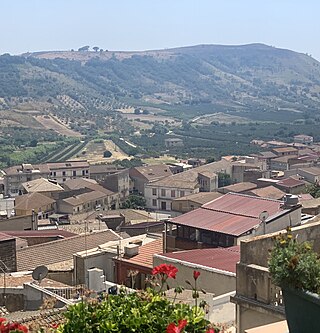
San Cono is a small village and comune in the Metropolitan City of Catania on the island of Sicily, southern Italy. It is an agricultural community, and is known particularly for its production of prickly pears.

The Vallombrosians are a monastic religious order in the Catholic Church. They are named after the location of their motherhouse founded in Vallombrosa, situated 30 km from Florence on the northwest slope of Monte Secchieta in the Pratomagno chain. They use the postnominal abbreviation OSBVall to distinguish themselves from other Benedictines, who generally use the abbreviation OSB.

Placidus was a disciple of Benedict of Nursia. He was the son of the patrician Tertullus, was brought as a child to Benedict at Sublaqueum (Subiaco) and dedicated to God as provided for in chapter 69 of the Rule of St. Benedict (oblate).

Giovanni Gualberto was an Italian Roman Catholic abbot and the founder of the Vallumbrosan Order. Born into a noble family, Gualberto was a predictably vain individual who sought pleasure in vanities and romantic intrigues. When his older brother Ugo was murdered, Gualberto set out for revenge. He found the murderer in Florence, but as it was Good Friday, granted the killer's plea for mercy. Soon after Gualberto became a member of the Order of Saint Benedict though he left in order to found his own congregation. He condemned nepotism and all simoniacal actions and was known for the pureness and meekness of his faith. Even popes held him in high esteem.
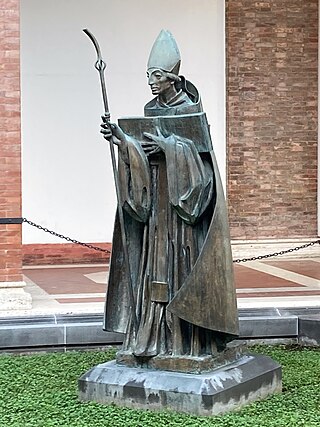
Sant'Anselmo all'Aventino is a complex located on the Piazza Cavalieri di Malta Square on the Aventine Hill in Rome's Ripa rione and overseen by the Benedictine Confederation and the Abbot Primate. The Sant'Anselmo complex, also known as the "Primatial Abbey of Sant'Anselmo" because it is the residence of the Abbot Primate, consists of: an ecclesiastical residential college known as the "College of Sant'Anselmo" ; a university known as the "Pontifical Athenaeum of Saint Anselm" ; the "Church of Sant'Anselmo" ; and the curial headquarters of the "Benedictine Confederation" and Abbot Primate. The complex and associated institutions are named in honor of the Benedictine monk Saint Anselm of Canterbury.
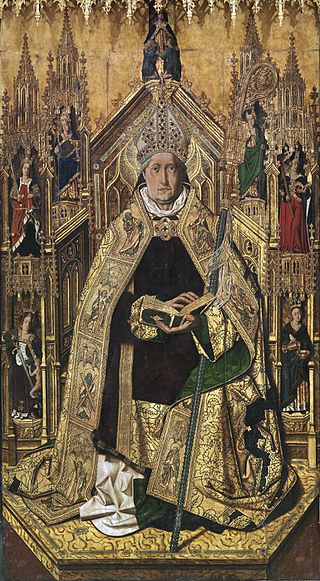
Dominic of Silos was a Spanish monk, to whom the Abbey of Santo Domingo de Silos, where he served as the abbot, is dedicated. He is revered as a saint in the Catholic Church. His feast day is 20 December.

The Sacra di San Michele, sometimes known as Saint Michael's Abbey, is a religious complex on Mount Pirchiriano, situated on the south side of the Val di Susa in the territory of the municipality of Sant'Ambrogio di Torino, in the Metropolitan City of Turin, Piedmont region of northwestern Italy. The abbey, which for much of its history was under Benedictine rule, is now entrusted to the Rosminians.
Saint Bononio was a Benedictine abbot and saint of the Catholic Church.

Novalesa Abbey is a Benedictine monastery in the Metropolitan City of Turin, Piedmont, Italy. It was founded in 726, and dedicated to Saint Peter and Saint Andrew.
Abadía de Cristo Rey, El Siambón, Tucumán, Argentina, is a Benedictine monastery of the Cono-Sur Congregation. Founded by the monks of Abadía del Niño Dios in 1956, the monastery went on to become an abbey. As of 2000, the monastery was home to twelve monks, under the leadership of Prior Administrator Juan Carlos Romano.
Abadía de San Benito, Luján, Buenos Aires Province, Argentina, is a Benedictine monastery of the Cono-Sur Congregation. Originally established in Buenos Aires, the monastery became an abbey in 1950 and later transferred to the outskirts of Luján. As of 2020, the monastery was home to 13 monks, under the leadership of Abbot P. Jorge Moran.
Abadía del Niño Dios, Victoria, Entre Ríos Province, Argentina, is a Benedictine monastery of the Cono-Sur Congregation. Upon its establishment in 1899, it became the first Benedictine foundation in Hispanic America. As of 2000, the monastery was home to 42 monks, under the leadership of Abbot Fr Carlos Martín Oberti.

The Abbey of St. Peter is a Benedictine abbey in Assisi inhabited by a small community of monks belonging to the Cassinese Congregation. The monastery has supported a hospital for the sick, an agricultural colony, and an orphanage run by the Stigmata Sisters.

San Potito is a church in Naples dedicated to Potitus, who was tortured to death in Epirus or Ascoli in 166. It is located on the San Potito hill on via Tommaso Salvatori.
